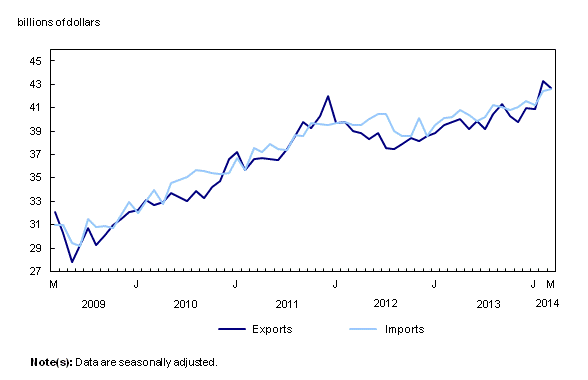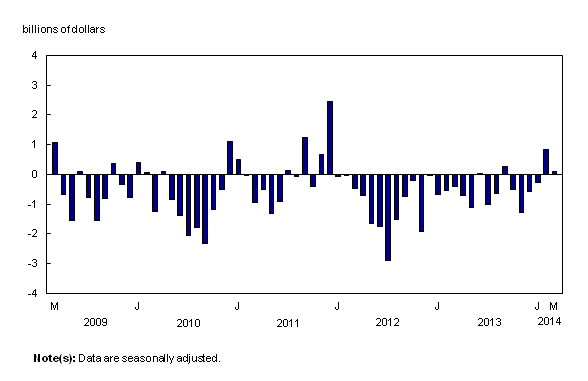Canadian international merchandise trade, March 2014

Canada Statistics has issued the following data:
Canada’s merchandise exports declined 1.4% in March, while imports edged up 0.4%. As a result, Canada’s trade surplus with the world narrowed from $847 million in February to $79 million in March.
Chart 1
Exports and imports

Exports declined to $42.7 billion, with prices down 2.0% and volumes up 0.7%. Energy products were the main contributor to the overall decline in exports.
Imports edged up to $42.6 billion, as increases in basic and industrial chemical, plastic and rubber products as well as consumer goods were largely offset by declines in electronic and electrical equipment and parts as well as energy products. Overall, prices were up 0.4% and volumes were unchanged.
Exports to the United States declined 2.5% to $32.2 billion, on lower values of energy products, while imports from the United States rose 1.0% to $28.5 billion. Consequently, Canada’s trade surplus with the United States narrowed from $4.9 billion in February to $3.8 billion in March.
Exports to countries other than the United States rose 2.5% to $10.5 billion, led by the European Union, up 8.5%. Imports from countries other than the United States declined 0.7% to $14.2 billion. Lower imports from the principal trading area “Other Organisation for Economic Co-operation and Development countries” (-9.5%) were largely offset by higher imports from the European Union (+7.1%). As a result, Canada’s trade deficit with countries other than the United States went from $4.0 billion in February to $3.7 billion in March.
Exports down on energy products
Exports of energy products fell 7.9% to $11.2 billion in March, following three consecutive months of significant increases. Crude oil and crude bitumen (-7.3%) and natural gas (-17.5%) were the main contributors to the decline in March, as well as to the previous three increases. Overall, prices (-4.8%) and volumes (-3.2%) were down.
Exports of forestry products and building and packaging materials declined 7.6% to $2.7 billion, entirely on volumes. Lower exports were reported for lumber and other sawmill and millwork products (-16.9%) as well as pulp and paper stock (-7.5%).
Exports of metal and non-metallic mineral products rose 8.0% to $4.6 billion, led by unwrought precious metals and precious metal alloys (+20.3%). Overall, volumes were up 7.3%.
Imports edge up
Imports of basic and industrial chemical, plastic and rubber products increased 6.3% to $3.7 billion in March. Lubricants and other petroleum refinery products (+21.2%) and fertilizer, pesticide and other chemical products (+12.7%) both contributed to the section’s gains. Overall, volumes grew 3.9% and prices rose 2.3%.
Imports of consumer goods rose 1.7% to $8.6 billion, as volumes increased 2.4%. Imports of pharmaceutical and medicinal products led the increase, up 9.5% in March following a 9.4% decline in February.
Imports of energy products declined 2.6% to $4.0 billion. Imports of crude oil and crude bitumen, down 14.7% to $1.9 billion, were the main factor behind the decrease. Partially offsetting this decline were imports of natural gas, which rose 68.5% to a record high $592 million, primarily as a result of higher prices.
Imports of electronic and electrical equipment and parts decreased 3.7% to $4.7 billion. Declines were reported for all commodity groupings, led by communications and audio and video equipment (-4.9%). Overall, volumes fell 4.9%.
Chart 2
Trade balance

Source: StatCan





























